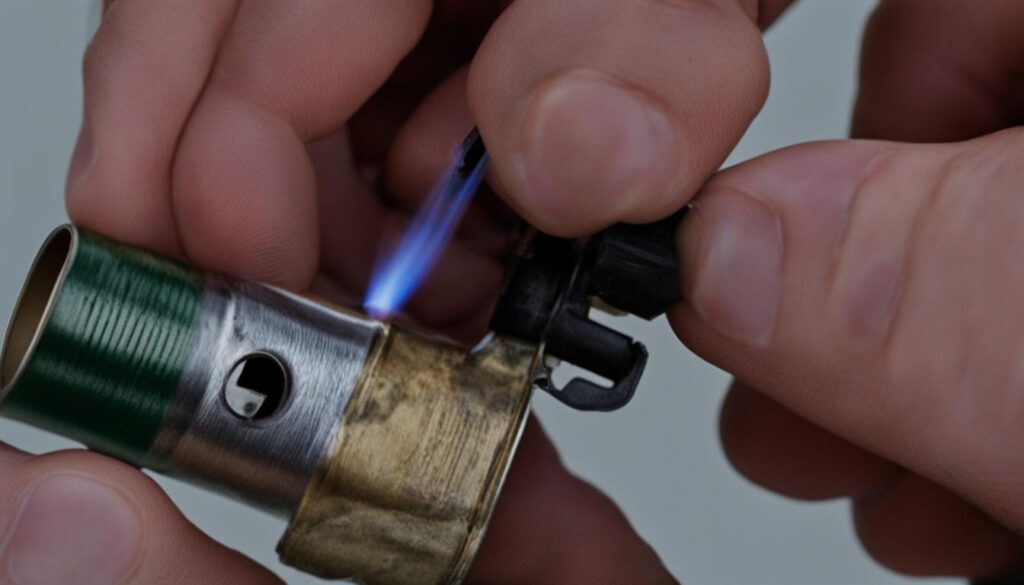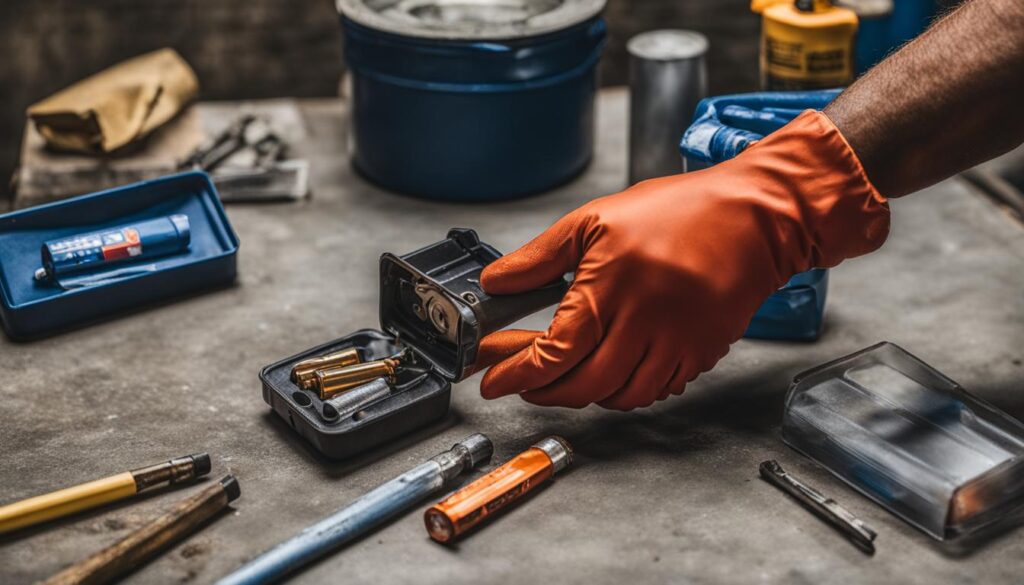Refilling a Bic lighter is a cost-effective and environmentally friendly alternative to buying new lighters. While the manufacturer does not endorse refilling, it can be done safely with the right equipment and precautions. There are different methods on how to refill Bic lighter, including using a push pin and rubber grommets or installing a refill valve. This article will provide step-by-step instructions on how to safely refill a Bic lighter.
How to Refill Bic Lighter
- Refilling a Bic lighter is a cost-effective and environmentally friendly option.
- Ensure the lighter is completely empty before refilling to prevent mixing of fluids.
- Gather the necessary materials before starting the refill process.
- Hold the lighter upside down when refilling to allow the butane to flow properly.
- Follow safety precautions when handling flammable materials and fire.
1. Gather the Materials
To refill a Bic lighter, you will need a few materials. These include butane, a push pin, and rubber grommets. These materials can be purchased at most hardware stores. It may also be helpful to have a pair of clippers and a file on hand for filing down the pushpin. Make sure to gather all these materials before starting the refill process.
Butane
The first material you will need is butane. This is the fuel that will refill your lighter. You can find butane canisters at hardware stores or online. It is important to choose a butane brand that is compatible with lighters and has a long nozzle for easy refilling.
Push Pin
A push pin will be used to puncture the valve of the lighter for refilling. It is recommended to use a push pin with a sharp and sturdy tip. You can find push pins at office supply stores or online. Alternatively, you can use a small needle or a thumbtack if a push pin is not available.
Rubber Grommets
Rubber grommets are small rubber rings that will create a seal between the butane canister and the lighter. They can be found in hardware stores or online. Rubber grommets help prevent any leaks during the refilling process and ensure a secure connection between the canister and the lighter.
2. Prepare the Lighter
Before refilling the Bic lighter, it is important to properly prepare it. Start by ensuring that the lighter is completely empty. Give it a gentle shake and try to ignite it to make sure there is no remaining fluid. If any fluid sprays out when removing the pin, be sure to empty the lighter completely. This step is crucial to prevent any mixing of old and new butane, ensuring a safe refill process.
Next, take a moment to remove any excess fluid from the lighter. This can be done by pressing down on the pin while it is still inserted in the valve. Allow any residual fluid to escape until the lighter is completely empty. Removing excess fluid will help prevent any leaks or potential hazards when refilling the lighter.
By properly preparing the lighter and ensuring it is empty of any fluid, you can safely move on to the next step of the refill process. Taking these precautions will help ensure a successful and safe refill of your Bic lighter.
3. Refill the Lighter
Now that you have prepared the Bic lighter, it’s time to refill it with butane. To do this, hold the lighter upside down to ensure that the butane flows properly. Insert the nozzle of the butane container into the hole at the bottom of the lighter. Gently press down on the container to release the butane into the lighter. It’s important to fill the lighter for about 5 seconds or until it is full. This will ensure that you have enough fuel to keep your lighter functioning for an extended period of time.
Remember to take caution while handling the butane and the lighter. Butane gas is highly flammable, so it’s crucial to avoid any open flames or sparks during the refill process. Additionally, ensure that you are in a well-ventilated area to prevent any buildup of gas. By following these safety measures, you can successfully refill your Bic lighter without any accidents.
Once you have filled the lighter, remove the butane container and cover the valve with your thumb immediately to prevent any gas from escaping. Then, insert the pushpin back into the hole in the valve as fast as possible to seal it shut. This will help maintain the pressure inside the lighter and ensure that the butane doesn’t leak out. If you prefer a neater appearance, you can use metal snippers to cut off the top of the pushpin. This will give your lighter a more streamlined look.
4. Seal the Lighter
After refilling the Bic lighter, it’s crucial to seal the valve to prevent any gas from escaping. To do this, cover the valve immediately with your thumb once you remove the butane container. This will ensure that no butane is released unintentionally. Then, take the pushpin and insert it back into the hole in the valve as quickly as possible to seal it shut. The pushpin acts as a valve and prevents any butane from spilling out. If you prefer a more streamlined appearance, you can use metal snippers to cut off the top of the pushpin.
Why is it important to seal the lighter?
Sealing the lighter is crucial to maintain the integrity of the refill and ensure safe usage. By covering the valve and inserting the pushpin, you create a tight seal that prevents any gas leakage. This is important because butane gas is highly flammable, and any unintentional release can pose a serious safety risk. By taking this simple step, you can use your refilled Bic lighter confidently, knowing that it won’t leak and cause any accidents.
When to use metal snippers?
If you want a cleaner and more professional-looking seal, you can consider using metal snippers to cut off the top of the pushpin. This will remove the excess material and make the seal more compact. However, using metal snippers is optional, and it doesn’t affect the functionality of the sealed valve. It’s purely a cosmetic choice for those who prefer a sleeker appearance for their refilled Bic lighter.
Safety Precautions
When it comes to refilling a Bic lighter, it is crucial to prioritize safety. Butane gas, which is used to refill lighters, is highly flammable and can be dangerous if not handled properly. To ensure a safe refilling process, follow these important safety precautions.
Handle Flammable Gas with Caution
First and foremost, always treat butane gas as a flammable substance. Keep it away from open flames or any potential sources of ignition. When refilling your Bic lighter, make sure you are in a well-ventilated area to prevent the buildup of gas. Avoid smoking or using any other forms of fire during the refilling process to minimize the risk of accidents.
Wash Your Hands Thoroughly
After refilling the lighter, it is essential to wash your hands thoroughly. Lighter fluid residue can be left on your skin, which may cause irritation or even pose health risks if ingested. Use soap and water to clean your hands, ensuring that all traces of the lighter fluid are removed. This simple step will help keep you safe and prevent any potential contamination.
Use Premium Butane Fuel
Choosing the right fuel for your Bic lighter is crucial for its overall performance and safety. Opt for premium butane fuel, as it tends to have fewer impurities that can potentially clog the lighter over time. Premium butane also helps maintain a consistent flame and reduces the risk of malfunctions or accidents. Investing in high-quality fuel is a small price to pay for peace of mind and long-term safety.
Conclusion
Refilling a Bic lighter is an environmentally friendly and cost-effective alternative to constantly buying new lighters. While the manufacturer may not endorse it, refilling a Bic lighter can be done safely with proper precautions. By following the step-by-step instructions outlined in this article and taking necessary safety measures, you can continue to use your Bic lighter for an extended period of time.
Refilling a Bic lighter is not only a practical choice but also a more sustainable one. By refilling instead of discarding, you are reducing waste and minimizing your impact on the environment. Additionally, it can save you money in the long run by eliminating the need to regularly purchase new lighters.
Remember, safety should always be a top priority when working with flammable materials. Take the necessary precautions, such as washing your hands thoroughly after refilling and using premium butane fuel to prevent any impurities. Handle lighters and fire with care to avoid accidents and ensure a safe experience.
Refilling your Bic lighter is a simple and rewarding process. So why not give it a try? Help reduce waste, save money, and enjoy the convenience of a lighter that lasts. Keep in mind the eco-friendly, cost-effective, and safe aspects of refilling and make it a part of your routine.
FAQ
Is refilling a Bic lighter safe?
While the manufacturer does not endorse it, refilling a Bic lighter can be done safely with proper precautions.
What materials do I need to refill a Bic lighter?
You will need butane, a push pin, rubber grommets, and optionally, clippers and a file.
How do I prepare the Bic lighter before refilling?
Make sure the lighter is completely empty by shaking it and trying to light it. Empty any remaining fluid to prevent mixing old and new butane.
How do I refill the Bic lighter?
Hold the lighter upside down and insert the nozzle of the butane container into the hole at the bottom of the lighter. Gently push down to release the butane and fill the lighter for about 5 seconds.
How do I seal the Bic lighter after refilling?
Remove the butane container and cover the valve with your thumb to prevent gas from escaping. Insert the pushpin back into the hole in the valve to seal it shut.
What safety precautions should I take when refilling a Bic lighter?
Wash your hands thoroughly after refilling to remove any lighter fluid residue. Use premium butane fuel to prevent clogs and handle all flammable materials with caution. Always prioritize safety when working with fire.
Why should I consider refilling a Bic lighter?
Refilling a Bic lighter is cost-effective and environmentally friendly, as it reduces waste and saves money in the long run.


